What is HVAC system or its meaning? A very common question. HVAC is a very common word now a day to make ourselves comfortable. The weather conditions are different based on the locations, seasons, etc. In a room, if there is heat-generating equipment, the temperature my very high even in the winter. Now, how does HVAC makes us comfortable as well as help to control the temperature? Let’s explore the details of the HVAC system!
What is HVAC system? Meaning, Definition, History
What does HVAC stand for?
HVAC is an abbreviation for heating, ventilation, and air conditioning. Here,
| H – Heating | A – Air |
| V – Ventilation | C – Conditioning |
HVAC includes Heating units, heat pump, furnace, Ventilation, Comfort units, like split air conditioners, packaged air conditioners, chilled water system, etc. Filters, humidifiers, dehumidifiers, Ductwork, Controls etc.
HVAC Meaning
Let’s try to understand the meaning of HVAC! HVAC is a system by which heating, or ventilation of air conditioning together or individually can be done. This system can provide the required heating and cooling capacity to the residential and commercial buildings. HVAC units are available in various capacities based on the applications.
HVAC Definition
HVAC is a system that is able to provide heating, or ventilation, or air conditioning based on the requirements.
History of HVAC
Alfred Wolff made the first comfortable air conditioners and Willis Carrier first invented the first process air conditioners.
Why Does HVAC System Require? Purpose
Any building where the HVAC system is provided, has some specific purpose, it may be heating or ventilation or air conditioning or a combination of these.
01. Heating: The use of heating or cooling to control environmental (room) space;
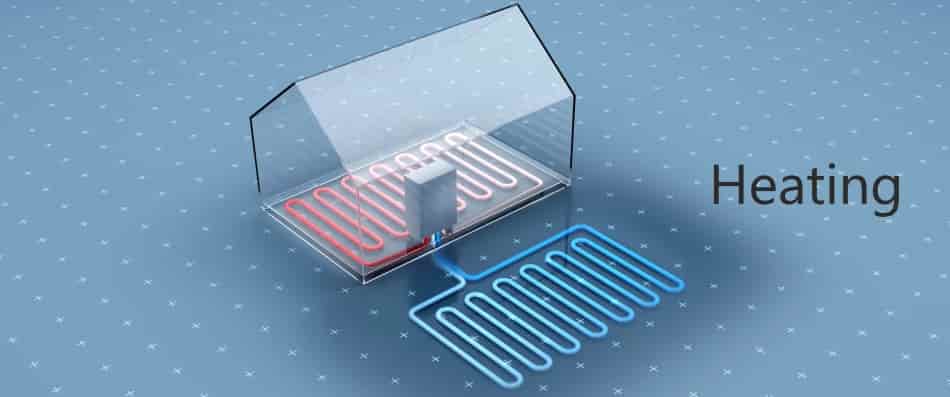
- It helps to increase the temperature in the winter season
- It helps to reduce the moisture content
02. Ventilation: The process of changing or replacing air in a space. It is used to remove moisture, odors, heat, carbon dioxide, etc, and replace it with ‘fresh air’. It is considered to be one of the most important factors for good indoor air quality. The design process would specify a number of ‘air changes’ within a room, depending on usage;
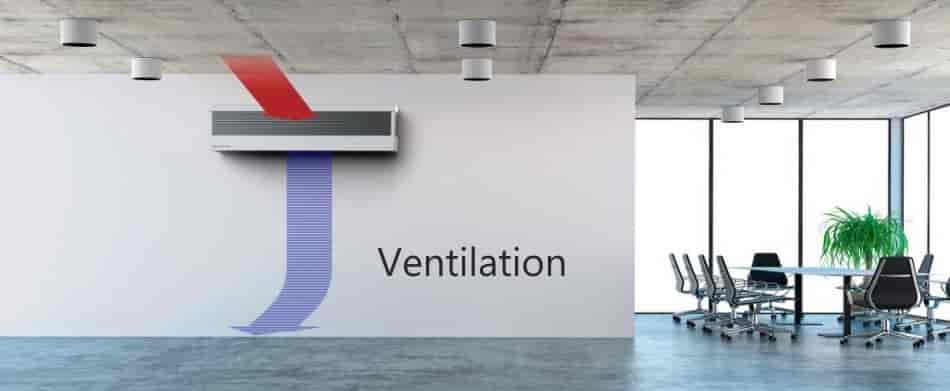
- It filtrates and cleans the indoor air.
- It includes oxygen in the air
- It can restrict the dust ingression into the conditioned space.
- It increases indoor air quality (IAQ)
- Ventilation helps to replace or exchange air within a space and improve indoor air quality (IAQ).
- It helps to reduce odors, smoke, heat, airborne bacteria, dust, carbon dioxide, and other gases
03. Air Conditioning: The supply air is ‘conditioned’ to control the temperature and humidity. Humans like a room temperature of 21 – 24°C and relative humidity of 40 – 60%. ‘Relative’ humidity is a measure of humidity compared to the maximum possible humidity.
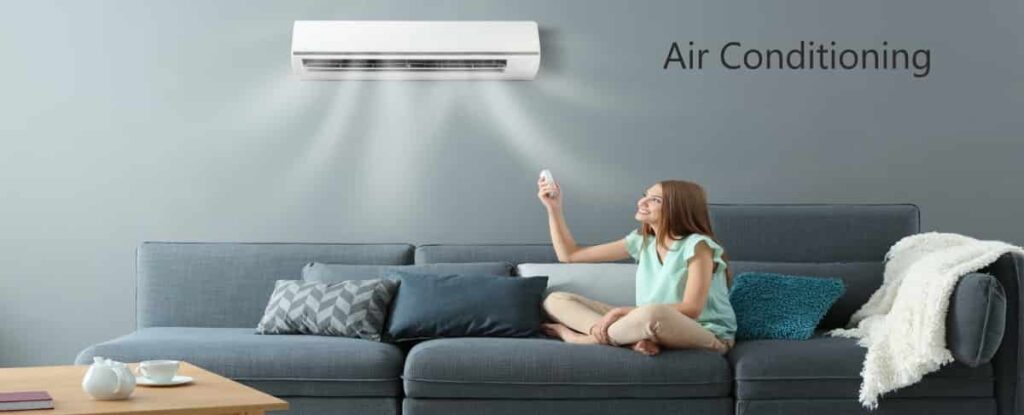
- It is used to move air between indoor and outdoor areas to meet the cooling or heating requirements.
- It makes us comfortable in hot summer
- It is able to make us comfortable in extreme winter too.
- It reduces the humidity level when weather is high humid
- It can reduce the humidity level down also, as required.
The main purpose of the air conditioning system Cooling, Heating, Humidifying, Dehumidifying, Control moisture content, Distribution of air, Filtration of air, Freshens air etc.
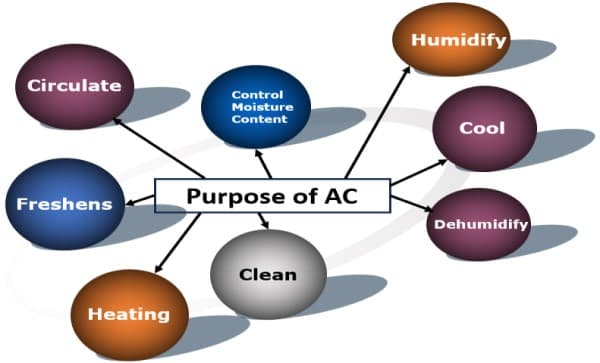
What are the Basic Components/Parts of an HVAC System?
There are so many components in the HVAC system, and it varies based on the type of system. However, to understand a basic concept, a few components are listed below considering each system in HVAC:
01. Heating: The basic parts of Heating system shall be as follows:
| Heating System | Parts |
| Boilers | |
| Hot water generator | |
| Furnace | |
| Heaters |
02. Ventilation: The basic parts of Ventilation system shall be as follows:
| Ventilation System | Parts |
| Supply fan | |
| Exhaust fans | |
| Louvers |
03. Air conditioning: The basic parts of the air conditioning system shall be as follows:
| AC components | AC components |
| Chillers | Fan Coil Units (FCUs) |
| Chilled water pumps | Split air conditioners |
| Condenser water pumps | Thermostats |
| Cooling towers | HVAC controls |
| Piping and valves | Heat pump |
| Air handling units (AHUs), | Associated electricals and controls |
| Sand trap louvers | |
| Diffusers, grilles, dampers, etc. | |
| Cooling coils | |
| Heating coils |
HVAC Basic Fundamentals, Meaning & Principles
HVAC Basic Fundamentals
The following HVAC basics shall be understood to know about HVAC:
| Thermodynamics | HVAC is related to the heat, work & energy, and their relationship. |
| Fluid Mechanics | In the water circuit, or refrigerant circuit, fluid mechanics are used to analyze. |
| Heat Transfer | Entire HVAC system is very closely related to the heat transfer. Heat is transferred from the conditioned space based on requirements. |
| Heating | Heaters are necessary for many places to increase the temperature as required. In this process, steam or air or hot water or electric heating coils are used. Heat can be transferred in three ways, Convection, Conduction & Radiation. |
| Ventilation | Ventilation is the process by which indoor contaminated or polluted air is replaced. It removes odors, smoke, heat, dust, airborne bacteria, or carbon dioxide, and to replenish oxygen. It is based on air changes per hour. Nos of air change depending on the type of applications. Methods for ventilating a building may be divided into forced and natural types. |
| Air conditioning | The air conditioning system is totally based on a refrigeration cycle consists of, evaporator coil, compressor, condensing coil, expansion valve, and Refrigerant, which circulates within the closed circuits. |
HVAC Basic Principle: Refrigeration Cycle
The basic principle of HVAC means the process of the main system. There are mainly two systems one is vapor compression system (VCR) and another is the vapor absorption system. The refrigeration process, VCR as follows,
You Can Explore: What is Refrigeration Cycle?
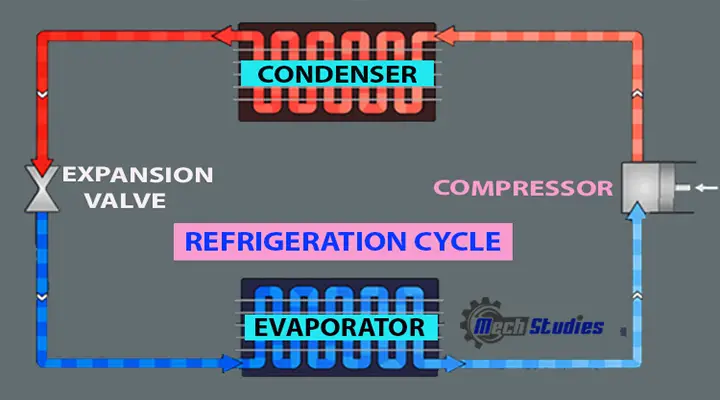
- In the evaporator, refrigerant starts evaporating and it takes latent heat of evaporation from the adjacent area i.e. air.
- A compressor is used after the evaporator. When the compressor starts, it creates a negative pressure and sucks the refrigerant vapor from the evaporator.
- The compressor compresses the refrigerant vapor and increases the pressure and temperature
- The high-pressure and high-temperature refrigerant vapor then goes to the condenser and reduces the heat and becomes liquid.
- The liquid refrigerant then comes to the evaporator again through an expansion valve.
- In the expansion valve, the flow of refrigerant is controlled.
How Does an HVAC System Work?
Let’s try to understand how does an HVAC system work with a clear explanation. Here, we will discuss the actual working procedure of the heating, ventilation & air conditioning process in an HVAC system:
How Does Heating in HVAC system work?
Heating is one part of the HVAC system, In the cold area, as well as where humidity is very high, heaters are required to increase the temperature as well as to reduce the moisture level within acceptable limits. Various kinds of heaters are used to generate heat in residential as well as commercial applications. The following can be used to produce heat,
- Boilers,
- Furnaces,
- Heat pumps
- Hydronic system
- Solar system
- Chimneys etc.
- Electricity
Boilers: The boiler is basically a pressure vessel. It has a combustion chamber to generate heat.
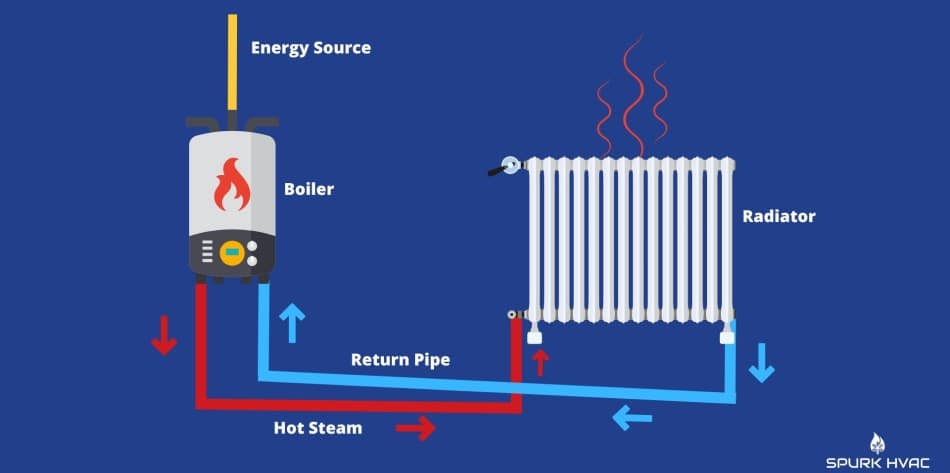
- Fuel like coal, wood, waste oil, fuel oil, etc. are burned in a combustion chamber.
- There is a working fluid normally water is used.
- There is a piping system to transfer heat around the combustion chamber for heat transfer.
- The heat from the combustion, heat the water.
- In many boilers, heat is produced by electrical resistance elements.
- Water becomes hot and used.
- In many boilers, water is heated up to steam formation & steam is used.
- Finally, water or steam released heat in the required space & return to the boiler through the piping system.
Boilers can be made of,
- Cast-iron,
- Carbon steel
- Stainless steel
- Aluminum
- Copper etc.
Furnace: In the furnace, there is a combustion chamber where fuel is burned. Here, no secondary working fluid is required. Air is heated and it is transferred through a duct to the space to be conditioned.
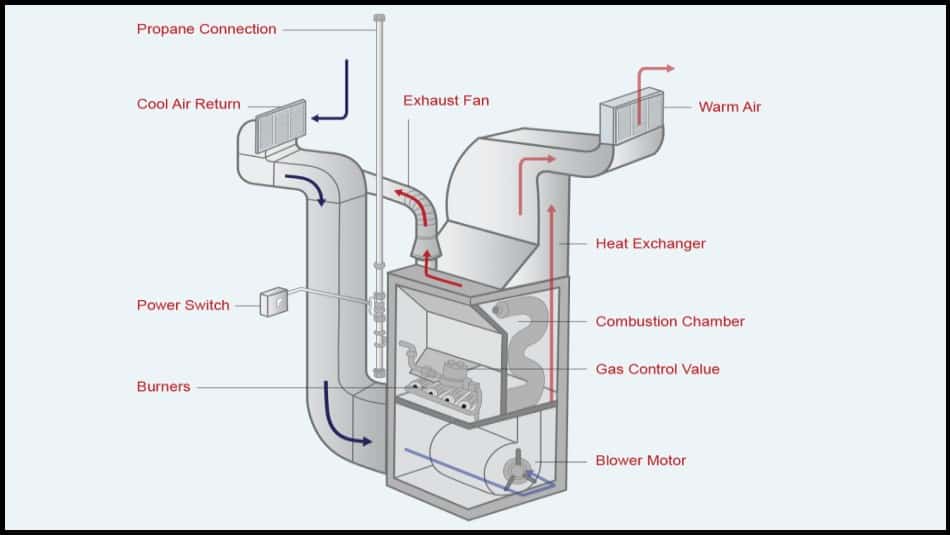
- The fan may be used to transfer air if required.
- It is used in residential as well as commercial applications.
- Natural gas, or oil or propane is used as fuel.
- Electric elements can also be used.
The furnace consists of,
- Casing
- Heat exchangers;
- Fuel or heat elements
- Burners
- Controls
- Vent
- Fan with motor
- Filter etc
Heat pumps: Heat pumps, now a day widely used to have duel functions like furnace & air conditioners.
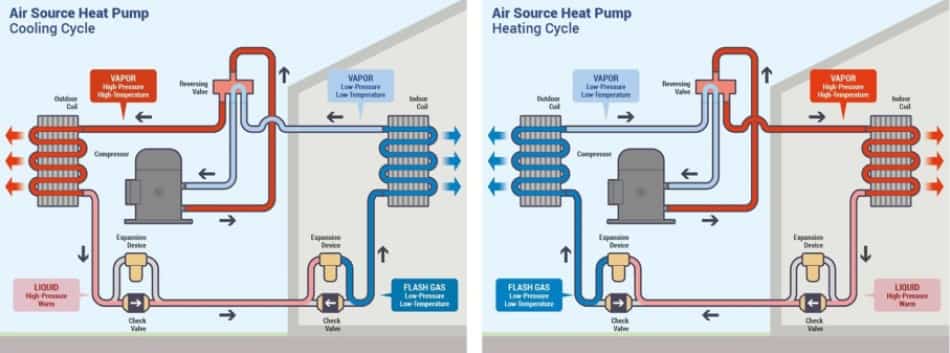
- When heating is required, the heat pumps transfer heat from cool outside to conditioned space.
- In this case, outside heat keeps the conditioned space warm.
- When cooling is required, heat pumps transfer the heat from the conditioned space to outside.
- Heat pumps are able to provide air conditioning requirements
- Because they move heat rather than generate heat, heat pumps can provide equivalent space conditioning at as little as one-quarter of the cost of operating conventional heating or cooling appliances.
Heat pumps can be,
- Air-to-air,
- water source,
Air to air heat pumps is widely used in normal residential applications.
Hydronic system: In a hydronic system, water is heated or cooled and circulated to the areas to be conditioned through pipes.
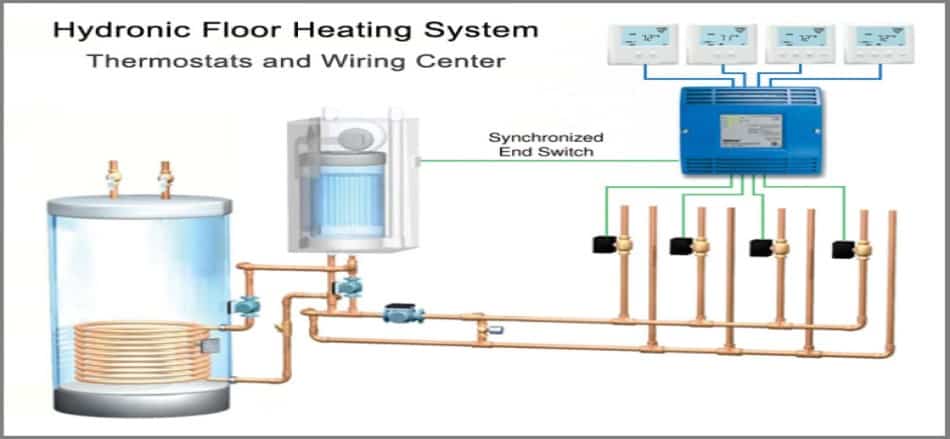
- The hydronic system circulates chilled water or hot water, based on requirements.
- A hydronic system is used to heat swimming pools, floors, etc.
- Boilers or other heating materials are used to heat the water.
- It cools by circulating cold water to the conditioned space.
- It normally uses water as a cooling or heating medium.
- It can have both a cooling and heating water loop as well.
- Water is circulated within a closed-loop piping system.
- Piping is connected to terminal units or air conditioners.
Solar System: Solar heating is widely used now a day. Water is heated by the sun or solar energy and that energy helps for the heating of the space. There is various way, to harness solar energy & use to get heat energy.
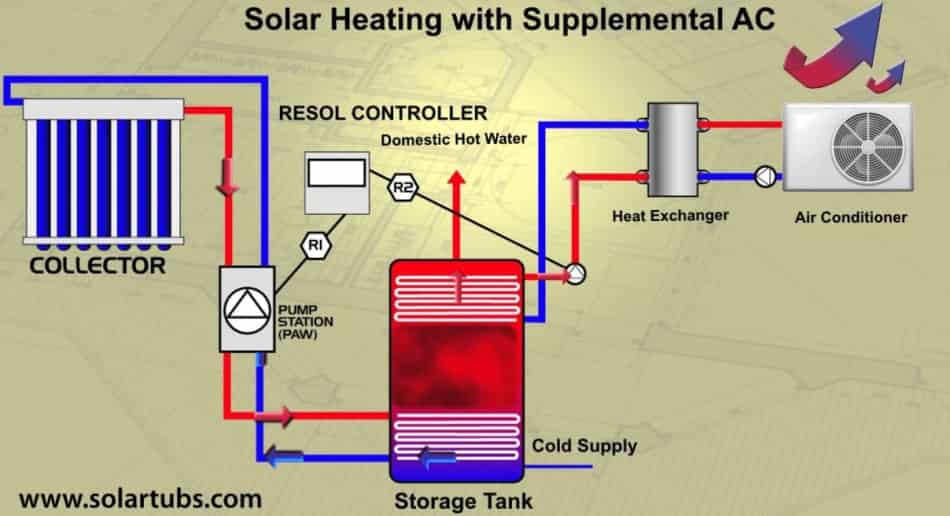
- There are photovoltaic panels to harness solar energy & use in heating
- It helps for the central heating system also
- It generates electricity which helps to heat
Chimneys: Chimneys are used to control the heat by controlling the draft to convey flue gas from a furnace or boiler to the outdoors.
Electricity: Electricity is widely used to heat the heating elements & control the heating requirements.
How Does Ventilation in HVAC system work?
Ventilation is one of the main parts of HVAC. It helps to provide fresh air into the conditioned space. It helps to limit a certain temperature range. Odors or fumes from an enclosed area can be removed by the ventilation system. There are many different ventilating methods:
Natural ventilation:
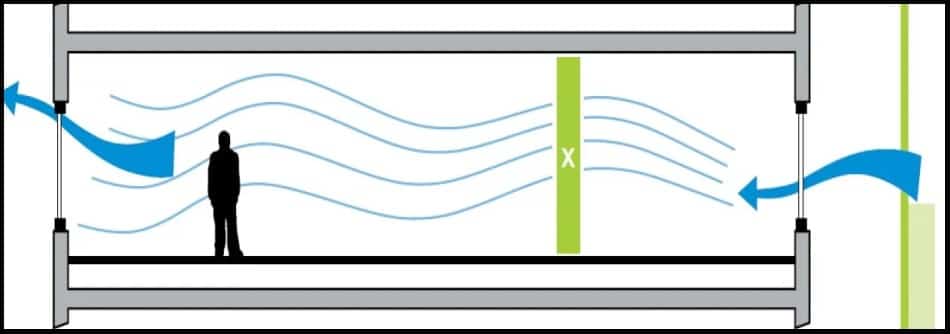
Natural ventilation is a primitive method and it is used for a long. In our home, we see small openings are given at a higher level. This is due to maintaining natural ventilation. Now a day, there are many modern methods have been created to make proper natural ventilation systems.
Push type ventilation:
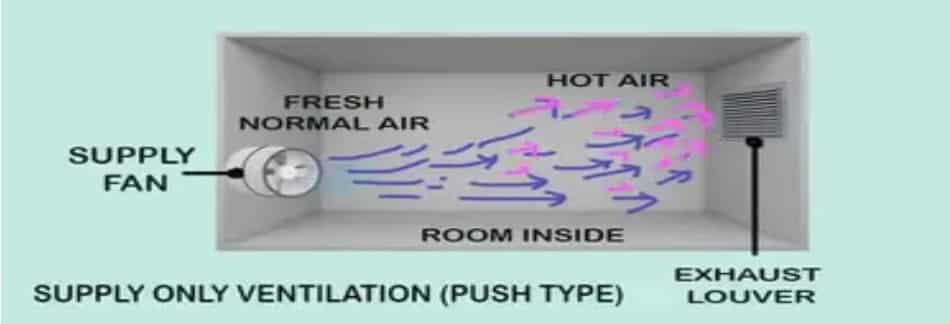
In the supply ventilation system, fresh air is forced to provide into the room and maintain positive pressure. Supply air fans are used and it may be non-ducted or ducted based on the capacity or requirements. This ventilation is also called as push ventilation.
Pull type ventilation:
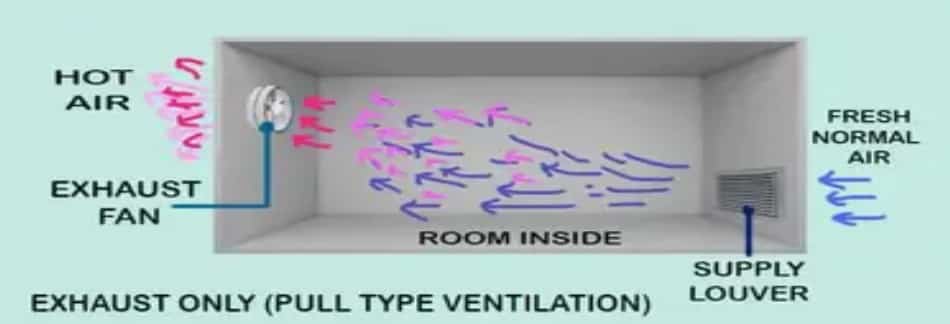
There are so many areas, where fumes or odors are produced like battery room or toilets or pantry etc. and it is required to be removed. In this case, exhaust fans are used to create negative pressure and remove it. This ventilation is known as pull ventilation.
Push-pull ventilation:
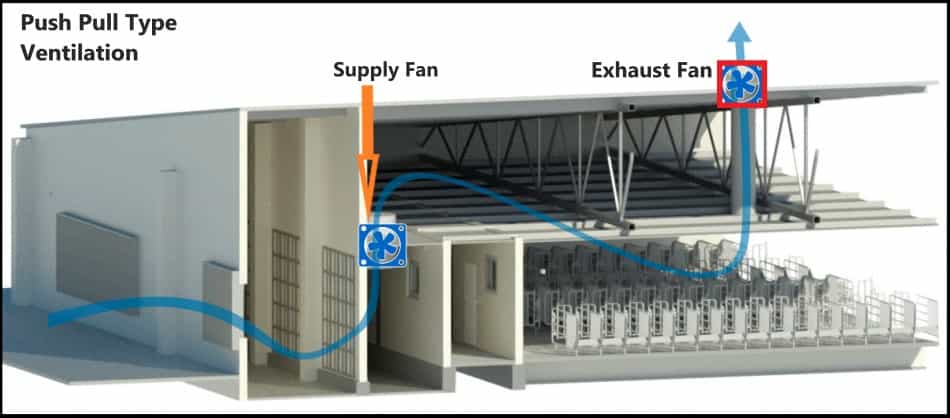
When supply and exhaust systems are required, we called the system a push-pull type ventilation system. It can be done by providing supply fans for the supply system and exhaust fans for the exhaust system.
Also, You Can Explore: Industrial Ventilation
How Does Air conditioning in HVAC system work?
Air conditioning systems are used to cool the conditioned space. How does air conditioning in HVAC system work, is described in the simplest way to get a basic idea,
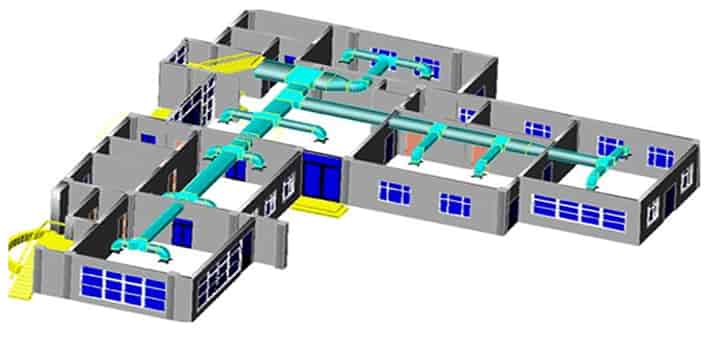
- Air Handling Unit: This unit is used to handle air. It consists of a cooling coil, filters, moisture eliminators, etc. Refrigerant is circulated through this cooling coil (evaporator) and gets the heat from the air.
- Refrigerant pickup heat: The air loses heat and becomes cool. On the other hand, refrigerant picks up the heat and gets heated. This refrigerant then passes through the compressor and condenser and comes back to the cooling coil through an expansion valve.
- Cooling of air: Cold air is circulated to the rooms and cools. After some time, it takes the heat from the room and circulated back to the air handling unit through fan suction. This recirculation continues.
- Filters: The air handling unit is having filters so that filtration is done and we get clean air.
- Moisture eliminator: The air handling unit is having a moisture eliminator, if the air is having moisture content, it separates from the air.
- Duct: Ducting system is used to circulate the air, definitely it depends on the type of system and the air quantity.
- Diffuser, grilles: Supply air is circulated through the duct at many points, these points are fitted with diffusers or grilles.
- Condensing units: Refrigerant releases heat in the condensing units. In this unit, condenser coils are used and with the help of condenser fans, heat transfer happens between refrigerant and air.
How Does HVAC system work in combination of all? Example
We have seen individual system like heating, ventilation & air conditioning working procedure, now, let’s see the combination of all i.e. HVAC working process step by step:
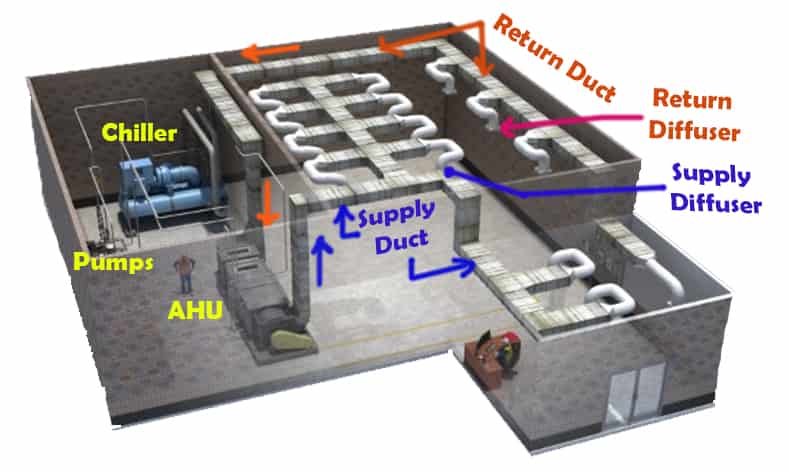
- Step-1 System: The system comprises chillers, pumps, air handling units, cooling towers, ducting & diffusers, refrigerant & condensate piping, electrical cable tray & cables, instrumentation cable tray & cables, fresh air louver, heater, and fresh air fans. We have considered these equipment only for simple illustration.
- Step-2 Calculation: The space shall be defined where the HVAC system is to be considered and need to calculate the requirements of fresh air, cooling & heating requirements, air quantity, etc.
- Step-2 Main Equipment to be installed: AHUs along with chillers (water cooled or air cooled, here water cooled considered) to be installed based on the required capacity. The chilled water piping along with chilled water pumps between AHU and chillers and condensate piping from the AHU shall be installed. Condensate water pumps shall be provided between chillers and cooling towers.
- Step-3 Air distribution & Ducting: AHU supplies conditioned air through ducts and return is also through ducts. In small systems, the duct is not provided. There are three types of air as well as ducts, fresh air which flows through the fresh air duct, return air which flows through a return air duct and supply air which flows through the supply air duct. Normal GI sheets are used, except for the hazardous area where SS is generally used.
- Step-4 Ventilation System: The air handling unit can be placed outside or inside based on project requirements (here it is inside) and supply air is supplied from AHU to the rooms and return air is returned back from the rooms. Now, required ventilated air is added to the return air and sometimes, it can be added directly to the AHU as well. A temperature transmitter is placed at the return air duct to get the temperature and it is synchronized with the control system so that room temperature can be monitored & controlled.
- Step-5 Fresh air fans: The ventilation requirements or fresh air shall be calculated based on air changes per hour basis or occupancy or per area basis based on codes & standards. Normally, fresh air is to be added to the return air duct near AHUs, however, many times, fresh air fans with filters are also provided if fresh air capacity is more.
- Step-6 Heaters: The heating system like heater shall be provided to get the desired temperature at the conditioned areas. Heater capacity can be get from the calculation and it can be placed in the AHU unit itself or at the duct.
- Step-7 Air circulation: Conditioned air is supplied from AHU to rooms through a centrifugal fans which is part of AHU. Duct is connected to the AHU and rooms and diffusers or grilles are provided in the duct for supply. Volume Control Dampers are provided to control the conditioned air and fire dampers are provided for fire wall crossings.
- Step-8 Power supply: Entire HVAC units like AHUs, ACCUs, Fans, dampers, heaters, etc. shall be provided from a HVAC distribution board or HVAC DB. Power cables and with cable trays are used from interconnection.
- Step-9 Control System: A control system equipment like HVAC control panel (microprocessor based or PLC based) shall be provided which is connected to the equipment and used to control the entire HVAC system. Control cables and with cable trays are used from interconnection.
- Step-10 Interfaces: All other systems like fire protection system, gas detections, FM gas, plant control philosophy shall be considered based on project requirements.
Difference between HVAC and Air Conditioning
Don’t be confused between HVAC and air conditioning. Air conditioning is simply a part of HVAC. Don’t think HVAC means big systems like a central system and air conditioning means a normal split system. Just remember, air conditioning is a part of HVAC.
Classification of Air Conditioning in HVAC Systems
There are so many types of HVAC systems, and the working principle of air conditioners are different. However, few of the standards system are explained for understanding. The HVAC systems are classified mainly into two categories – Central Air Conditioning (Central AC) & Non-Central AC
Central Air Conditioning (Central AC)
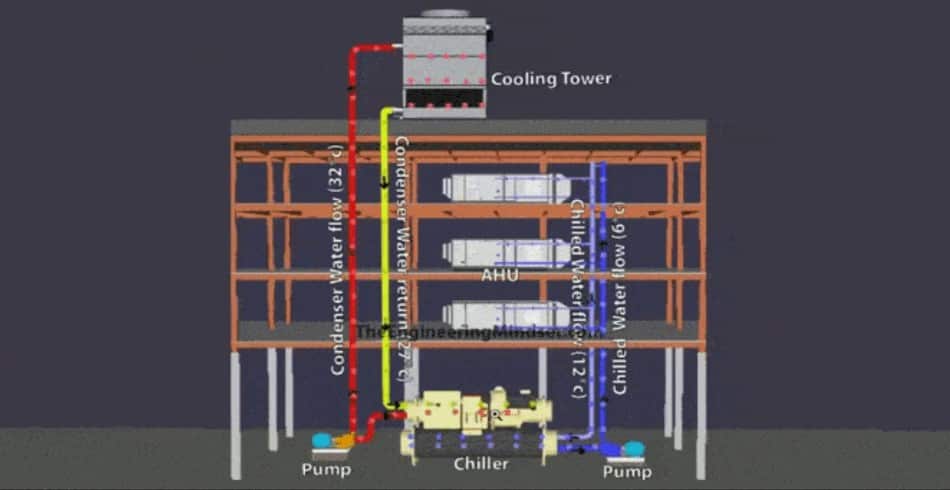
A central air-conditioning system means the HVAC system which conditions centrally and can be of various options like water cooled chiller system, air cooled chiller system, VRF system, ductable split AC, hybrid split AC, ductable package AC.
Non-Central AC
Non-Central air-conditioning systems can be of various options like window AC, non-ductable split AC, multi-split AC, cassette AC, floor standing AC, etc.
HVAC system can also be classified based on functionality as well as per below:
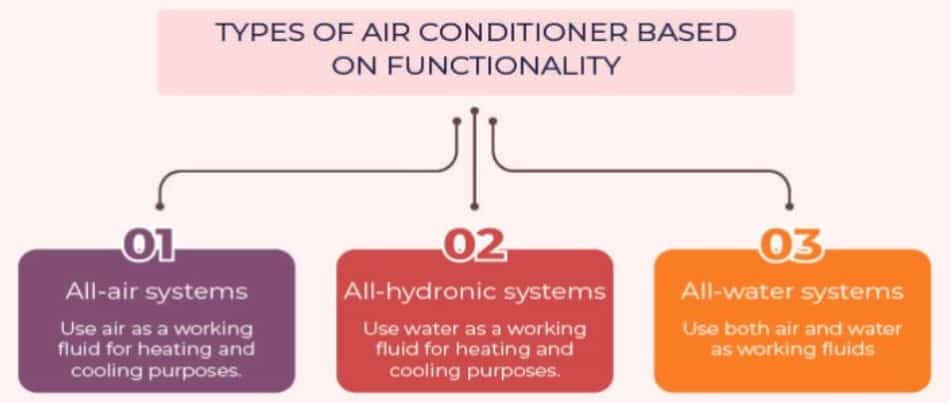
Here, we have captured a few widely used HVAC systems in various industries.
01. Window air-conditioner
For small capacity and to meet normal residential cooling, window-type air conditioners are used. It consists of an evaporator, compressor, condenser, expansion valve, filter, controls, etc. in a single unit. It is placed in a room that has an exposed wall. Evaporator portions will be inside the room. The compressor portion will be outside.

- Advantages: (1) Low price (2) Easily available (3) Good for small room applications
- Disadvantages: (1) Noise is high (2) More vibration (3) Not available with high capacity (4) Not applicable for industrial use (5) Not good for installation in existing building as wall opening is required (6) Exposed wall is required
- Capacity Range: 0.5 TR to 2.0 TR
02. Split system
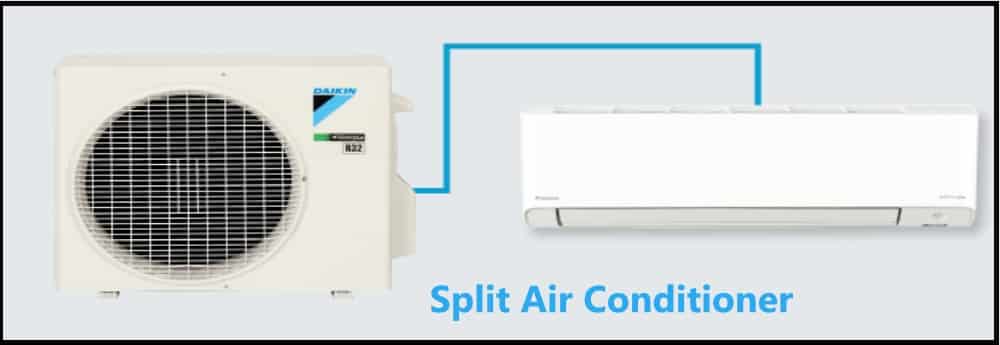
Split AC means air conditioning divides into two parts, indoor and outdoor. The indoor unit consists of an evaporator, and expansion valve. The outdoor unit consists of a compressor, condenser fans, and condensing coils. The indoor unit is placed inside the room. The outdoor unit is placed outside the room. The indoor and outdoor unit is connected by refrigerant piping. In a normal room, split air conditioners are widely used.
- This can be floor-mounted, ceiling-mounted, or wall mounted.
- Capacity Range: Non ducateble wall mounted split AC capacity varries from 0.75 TR to 2.5 TR. A few companies manufacture 3.0 TR split AC as well.
- Ductable split AC capacity is more than non ductable.
- Floor mounted split AC capacity is also more and it can be customized with higher capacities.
03. Package AC
Packaged AC means all components are packed in a single unit. If you observe, you will see both indoor and outdoor units are placed in a single packaged. It consists, blower, heating, cooling elements, filter racks, chambers, etc.
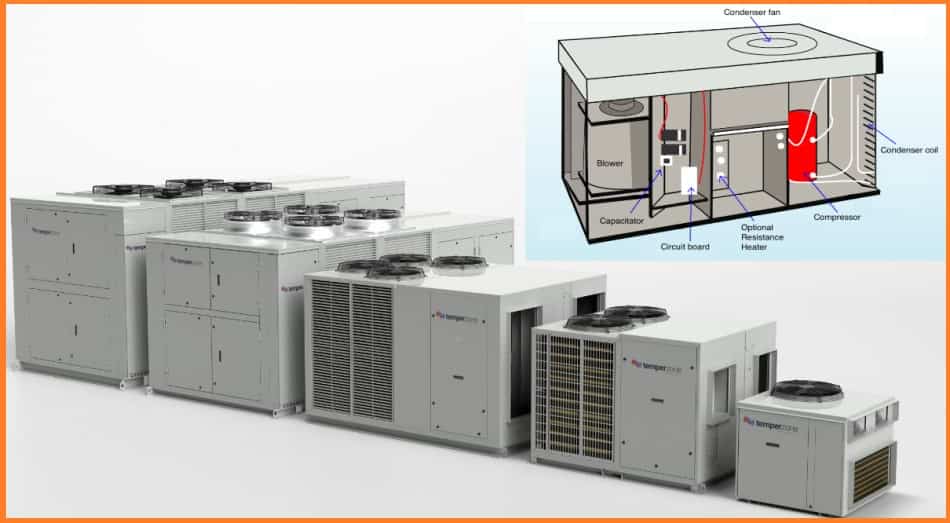
Normally, packaged air conditioners are used when medium capacities are required. Ductwork is connected to get the supply air into the conditioned space. To get return air from the room, a separate return duct is also provided. Normally condenser of packaged units is cooled by air, but it can be cooled by water as well.
04. Central AC
Central AC is of two categories. DX type and chilled water type.
DX Central AC
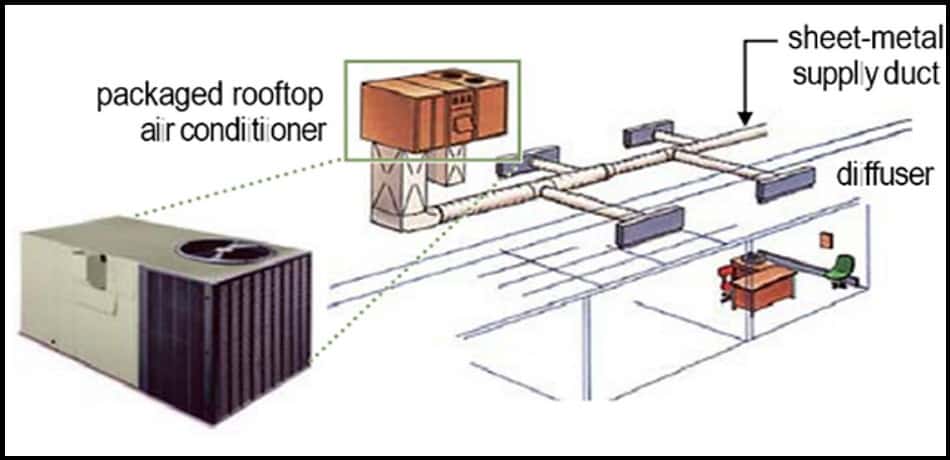
DX means direct expansion that means air directly comes in contact with cooling coil where cooling medium is flowing. It can be packaged air conditioners and air cooled chillers or a combination of air handling unit and air cooled condensing units.
Chilled water system
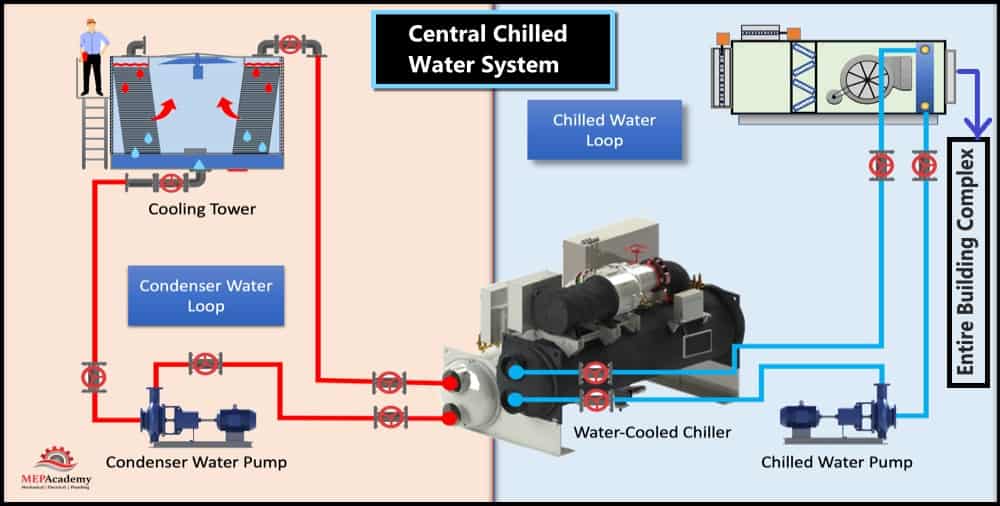
In this case, condensers are cooled by water circuits that connect with cooling towers. Check out to our detailed article on types of air conditioners, where we have described the details of each type of air conditioning system.
Why Does HVAC Maintenance Essential?
Installation of the HVAC system and running is not the end. There is one big term is associated with maintenance. During design, it is always considered the best and efficient system so that the HVAC system will have many benefits. Let’s see the benefits of proper maintenance and why is it required.
- Low Efficiency: Without maintenance, whatever efficient system you consider, will not give satisfactory results and the efficiency of the system will reduce.
- Operating cost: If the efficiency of the system reduces, then the individual equipment must work more to produce the same quantity of work and take more power.
- Health of HVAC system: The HVAC system includes different types of rotating equipment and it is essential to check the health of all equipment based on the manufacturer’s recommendations.
- Equipment Life: During HVAC design, the Manufacturer designs the system considering the project requirements, it may vary to 20 years or 25 years, or 30 years. Now, without maintenance, it cannot be achieved.
- Indoor Air Quality: Outside air consists of a lot of dust, other foreign pollutants. It depends on the place. There are so many filters used in the HVAC system to filtrate the outside air which increase the indoor air quality or IAQ.
- Reduce the Repair Cost: If the maintenance is not done at that time and it runs for a longer period then the equipment will be more problematic and repair costs will be more. Many times, repairing may not be sufficient and new parts need to be installed.
- Health & Safety: Safety is one of the most vital aspects of HVAC maintenance. Routine maintenance can eliminate the probability of fire or any accident.
- Sudden Failure: Sudden failure may hamper normal life. Suppose you live in a place where the outside temperature is 50 deg. C. Machine is running and all set. However, due to some reason, suddenly the machine stopped, or it is not giving required cooling. What will you do then? It is always better to have regular maintenance than sudden failure.
- Season Changes: The place where summer and winter temperature are high, then in the winter condition, AC may not work, and it became ideal for a couple of months. Keeping the unit ideal may impact the health of the HVAC system and it is mandatory to have maintenance at the starting of hot weather.
Advantages of HVAC system
The advantage of an HVAC system simply is a lot in human comfort as well as all industries.
- Due to HVAC only, we feel comfortable.
- When the weather is very hot, we use air conditioning.
- When the weather is very cool we use heaters.
- We are able to breathe fresh air.
- There are so many equipment that generate heat, HVAC is used to cool the same for proper functioning.
- In medical, space, etc. HVAC is widely used.
- Due to this, precise air filtration is possible which requires various research as well as critical medical applications.
Disadvantages of HVAC system
There are a few disadvantages as well,
- The main disadvantage is the environmental impacts. The refrigerant used in HVAC systems has Ozone Depletion Potential and Global Warming Potentials. These beaks the ozone layer which is not recommended. Now a day, environment-friendly refrigerants like R410a, R134a, R407c, etc. are used and these also harms our environment at some extent. Recently R1234yf is developed which is the best environment friendly refrigerant.
- Continuous heat release to the atmosphere, making trouble for nature.
- In the case of a centralized system, if the air is contaminated by chance, the same will be circulated which creates a problem.
- Split type air conditioners can not give fresh air, hence, for log time headache may be encountered.
- The HVAC system is costly and it is not feasible for poor people.
- Operating costs especially energy costs are very high.
- It requires periodic maintenance.
We have made a Detailed HVAC Design Engineering Course for Design Professionals, Freshers which you simply can love it.
for Design Professionals, Freshers which you simply can love it.
HVAC standards
There are so many codes and standards available for the HVAC design, construction, system design, equipment design, operation & maintenance, quality, safety, etc. Few are listed,
- ASHRAE
 ,
, - ISHRAE (India)
- SMACNA,
- ACCA,
- Uniform Mechanical Code,
- International Mechanical Code,
- AMCA
- AHRI
- DW
- National standards country wise
Conclusions
In this lesson, we have learned the basics of the HVAC system and meaning. Hope, it is clear, any doubt please let us know. In case you are looking to upgrade your career in HVAC by qualifying Certified HVAC Designer (ASHRAE), you can take our course in Udemy.
(ASHRAE), you can take our course in Udemy.
